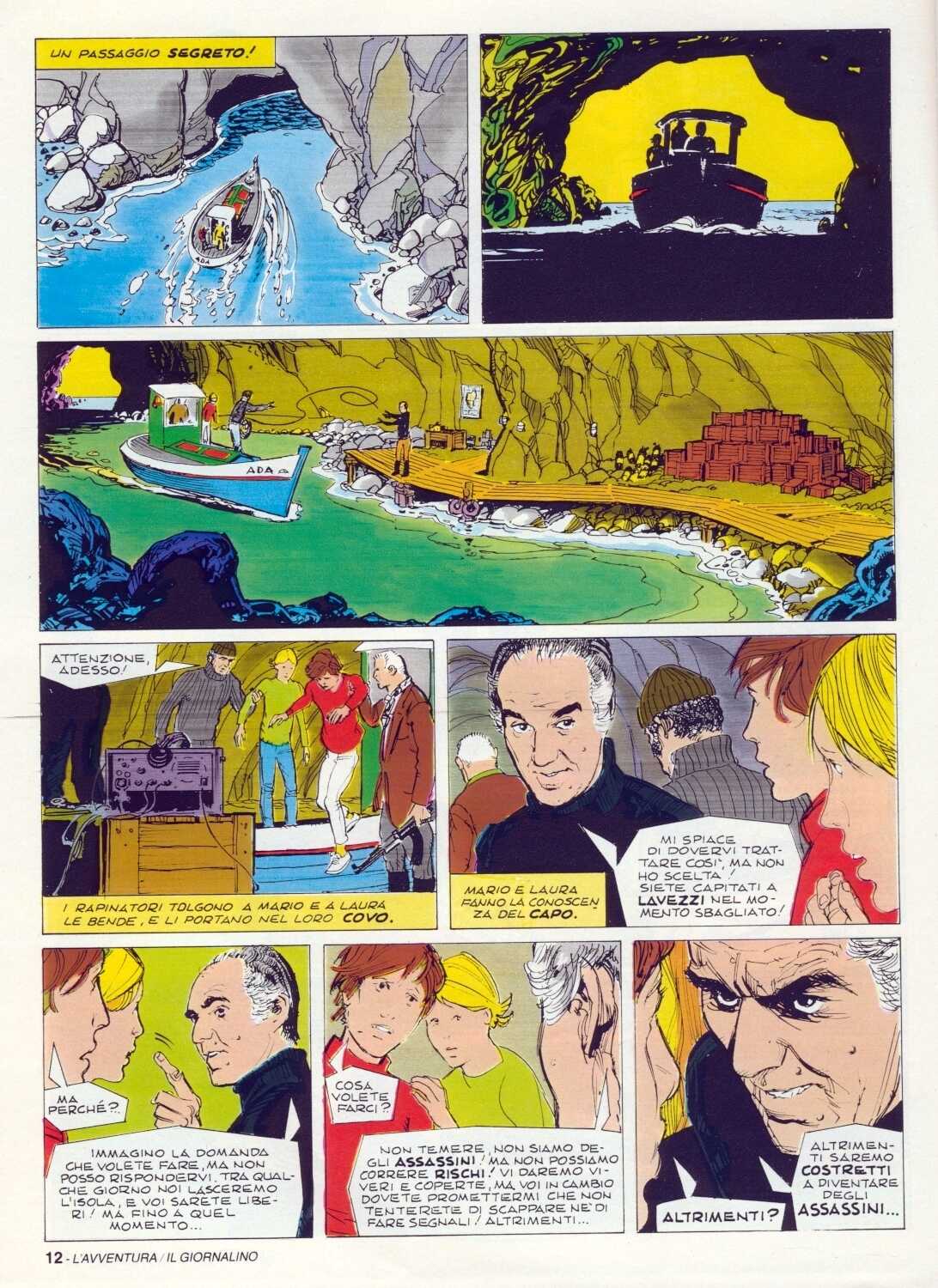
Michel Piccoli plays in De Luca’s comic story
Michel Piccoli plays in De Luca’s comic story
Michel Piccoli in Il segreto dell’isola episode of il commissario Spada. Published on Il Giornalino 1984
Jacques Daniel Michel Piccoli (27 December 1925 – 12 May 2020) was a French actor, producer and film director with a career spanning 70 years. He was lauded as one of the greatest French character actors of his generation who played a wide variety of roles and worked with many acclaimed directors.
Piccoli was born in Paris to a musical family; his French mother was a pianist and his Swiss father was a violinist. He appeared in many different roles, from seducer to cop to gangster to Pope, in more than 170 movies. He appeared in six films directed by Luis Buñuel including Belle de Jour (1967) and The Discreet Charm of the Bourgeoisie (1972), but also appeared as Brigitte Bardot’s husband in Jean-Luc Godards Contempt (1963) and as the main antagonist in Alfred Hitchcocks Topaz (1969). He also appeared in many films by Claude Sautet, sometimes co-starring in them with Romy Schneider.
In the 1990s, Piccoli also worked as a director on three films. One of his last leading roles was his portrayal of a depressed, newly elected pope in Nanni Moretti’s We Have a Pope (2011).
Piccoli was part of the Saint-Germain-des-Prés circle in the 1950s, which included Jean-Paul Sartre and Simone de Beauvoir. He was a member of the French Communist Party in this era. A life-long left-winger, he objected to repression in the Soviet bloc, and supported the Solidarity trade union in Poland.
Piccoli married three times, first to Éléonore Hirt, then for eleven years to the singer Juliette Gréco and finally to Ludivine Clerc. He had one daughter from his first marriage, Anne-Cordélia. He also had two adopted children with Ludivine Clerc. Piccoli died from complications of a stroke on 12 May 2020, aged 94.
Gianni De Luca (25 January 1927 – 6 June 1991, Italy)
Gianni De Luca was born in Gagliato, but he was raised in Rome from the age of 6. He provided the illustrations for an edition of Hector Malot’s novel ‘Sans Famille’ in 1945, and enrolled at the Faculty of Architecture in 1947. He gave up his studies after about two years to spend all his time on drawing comics. His first published story was ‘Il guercio sconfitto’ in Tam-Tam volume 2 by SEMCI in March 1946. He then published the comic books ‘Anac il distruttore’ and ‘La meravigliosa invenzione’ in the ‘Albi Roma’ series of the publishing house A.V.E. in 1946. In that same year, he made is first appearance in A.V.E.’s magazine Il Vittorioso with header designs. He made his actual debut in this weekly’s pages in 1947 with the serial ‘Il Mago Da Vinci’. This was followed by stories with the characters ‘Ted’ and ‘Jim Brady’, as well as the feature ‘Battaglia ai ciuffi bianchi’ with Alberto Malfatti for the younger readers.
In 1948-1949, he made illustrations for Jacovitti’s series of school diaries ‘Diario Vitt’, that were also published by A.V.E. He subsequently made fantasy serials like ‘I naufraghi del Mc. Person’, ‘Prora vichinga’, ‘L’impero del sole’, ‘La sfinge nera’ and ‘Il tempio delle genti’, that show influences of Hal Foster and Alex Raymond. He revamped his style for the 1951 story ‘Gli ultimi della Terra’ (‘The last on earth’), and returned to a more classical rendition for the historical stories ‘Il cantico dell’arco’ and ‘Le braccia di pietra’ (‘The Stone Arms’) in 1952.
He continued to contribute serials to Il Vittorioso until about 1957, including the thriller ‘Giallo alla 14ª strada’ (text by Mario Basari), in which he showcased his talent for drawing expressive characterizations of faces, and ‘Ragazzi di Ungheria’ (text by Lino Monchieri). Throughout his career, De Luca managed to apply the styles and techniques that befitted the stories he was assigned to draw.
By 1953, De Luca had also begun a long collaboration with Il Giornalino, the children’s magazine of Edizioni Paoline. His first story was ‘La leggenda della montagna’ (‘The legend of the mountain’), for which he used a photo-realistic technique based on light and dark. Between 1955 and 1959, he drew the feature ‘La più grande storia mai raccontata’ (‘The greatest story ever told’), that featured comic versions of Bible stories. This was followed between 1960 and 1968 by ‘I dodici in cammino’, a history of the Christian Church. During the 1960s, he was however mainly occupied with illustrating.
He returned to comics for a first time in 1967, with the melodramatic story ‘L’ultima Atlantide’, and then for good in 1969 with the western feature ‘Bob Jason’. Il Giornalino first published De Luca’s best-known serial from 1970. Together with writer Gian Luigi Gonano, he created the adventures of crime fighter ‘Il Commissario Spada’. The series was groundbreaking in many ways, since it introduced subjects like violence, organized crime, satanic sects, terrorists and murderers to the pages of a Catholic magazine for young readers, that was at the time mainly distributed in parishes. However, the duo continued the adventures of their hero until 1982.
Other notable work by De Luca is the Shakespearean cycle he made with Raul Traverso from 1975 to 1978. This includes faithful adaptations of plays like ‘The Tempest’, ‘Hamlet’ and ‘Romeo & Julia’. In the 1980s, he made ‘Il giornalino di Gian Burrasca’ with Claudio Nizzi, based on the novel of the same name by Vamba, and an adaptation of the Paulo Ferrarini novel ‘La Freccia Nera’ (1988).
He also embarked upon the ambitious saga ‘Paulus’ with Tommaso Mastrandrea, dealing with the Acts of the Apostles from a futuristic viewpoint. He additionally made comics biographies of Marilyn Monroe and the Italian comedian Totò. Gianni De Luca’s series ‘I Giorni Dell’Impero’, that was set in imperial Rome, was published posthumously, in its unfinished state.

